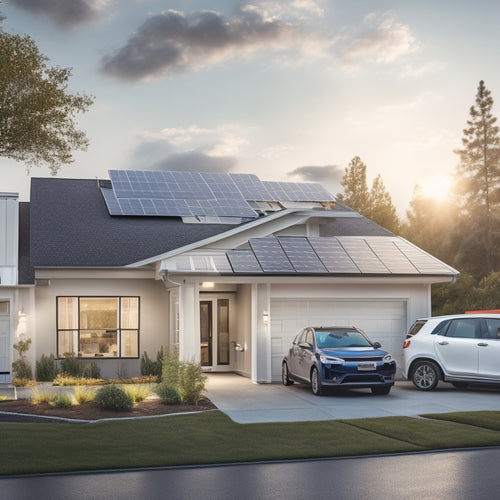
Solar Panel Wiring Installation in 7 Steps
Share
You'll start by preparing the installation site, making certain it's clear of debris and tripping hazards, and conducting a thorough site assessment to identify potential issues. Next, plan your wiring configuration, identifying the total power output of the solar array to determine wiring size and type. Then, install DC wiring, carefully planning and executing the process to guarantee ideal energy transmission. Connect to the inverter, choosing the right connection method to maximize energy production and reduce losses. Install AC wiring, evaluating wire sizing to make sure safe and efficient energy transmission. Ground the system properly, identifying grounding points and using corrosion-resistant equipment. Finally, test and inspect the wiring, verifying all electrical connections are secure and the system is properly grounded, and getting ready to guarantee your solar panel system operates at peak performance.
Key Takeaways
- Ensure a safe and efficient wiring installation by planning and configuring the wiring system according to the solar array's total power output.
- Select the appropriate wire gauge to minimize voltage drop, and route wiring to avoid damage, moisture exposure, or physical stress.
- Follow manufacturer guidelines and local electrical codes during connections, and label and secure cables to prevent damage or electrical shock.
- Perform safety inspections to identify overheating, electrical shock, or fire risks, and verify compatibility of all wiring and components with manufacturer specifications.
- Implement cable management techniques, such as using cable ties and securing to frames, to minimize energy losses and ensure system integrity.
Prepare the Installation Site
Prepare the Installation Site
First, make sure the installation site is clear of debris, obstructions, and tripping hazards. This is vital to guarantee a safe and efficient installation process.
You'll want to conduct a thorough site assessment to identify any potential issues that could compromise the integrity of your solar panel wiring installation.
Verify that the installation site meets all relevant safety regulations. Ascertain you have easy access to the area, and that it's free from any combustible materials.
You should also check for any overhead obstructions, such as power lines or tree branches, that could interfere with the installation.
Clear the area of any loose objects or materials that could cause tripping or other hazards.
Remember to wear appropriate personal protective equipment, such as hard hats and safety glasses, to protect yourself from potential risks.
Plan the Wiring Configuration
With the installation site ready, you can now focus on planning the wiring configuration for your solar panel installation. This vital step guarantees wiring safety and optimizes system efficiency.
Begin by identifying the total power output of your solar array, as this will determine the size and type of wiring required. Take into account the voltage and current ratings of your solar panels, as well as the distance between the array and the inverter.
You'll also need to decide on the wiring topology, such as a series or parallel configuration, and choose the appropriate wire sizes and types. Don't forget to take into account any electrical code requirements, such as grounding and bonding, to guarantee a safe and compliant installation.
Run the DC Wiring
About 90% of the DC wiring installation occurs between the solar array and the inverter, making this stage critical to the overall system's performance.
You'll need to carefully plan and execute the wiring to guarantee ideal energy transmission.
When running the DC wiring, select a wire gauge that minimizes voltage drop, as excessive voltage loss can greatly reduce your system's efficiency. A general rule of thumb is to keep voltage drop below 2%.
Using a wire gauge calculator or consulting a wiring diagram can help you determine the appropriate wire size for your specific system.
Next, verify the wiring is properly sized to handle the maximum possible current output of your solar array.
You should also consider the temperature rating of the wiring, as high temperatures can reduce the wire's current-carrying capacity.
Properly route the wiring to avoid damage, moisture exposure, or physical stress.
Secure the wiring using approved clamps, clips, or ties to guarantee a safe and reliable connection.
Connect to the Inverter
You'll connect the solar panel wiring to the inverter using one of several approved methods, including MC4 connectors, screw terminals, or DC connectors.
The chosen method will depend on the specific inverter and panel configurations, as well as local electrical codes and regulations.
As you make these connections, confirm the DC power transmission is secure, efficient, and meets all relevant safety standards.
Inverter Connection Methods
In the solar panel wiring installation process, connecting to the inverter is a critical step that requires careful attention to detail. You'll need to verify the inverter connection is secure, efficient, and meets the required electrical standards. There are several inverter connection methods to choose from, each with its advantages and disadvantages.
| Inverter Type | Inverter Efficiency | Connection Method |
|---|---|---|
| String Inverter | 95-97% | Connect multiple strings in parallel to the inverter input |
| Microinverter | 90-95% | Connect each panel to a separate microinverter, then to the grid |
| Power Optimizer | 95-98% | Connect each panel to a power optimizer, then to a string inverter |
| Central Inverter | 95-98% | Connect multiple strings in parallel to the inverter input, often used for large-scale installations |
When selecting an inverter connection method, consider factors such as system size, panel layout, and inverter efficiency. It's crucial to consult the inverter manufacturer's instructions and local electrical codes to verify a safe and efficient connection. By choosing the right inverter connection method, you'll be able to maximize your solar panel system's energy production and reduce energy losses.
DC Power Transmission
Having selected an inverter connection method, it's now time to focus on transmitting DC power from the solar panels to the inverter.
You'll need to verify that the DC power transmission is efficient, reliable, and safe. This involves selecting the right cables, connectors, and wiring configurations that can handle the voltage and current output of your solar panels.
When transmitting DC power, it's crucial to minimize energy losses to maximize solar efficiency. You can achieve this by using high-quality cables with low resistance, keeping the cable runs as short as possible, and avoiding unnecessary bends or kinks.
Additionally, consider using energy storage systems, such as batteries, to store excess energy generated during the day for use during the night or on cloudy days.
As you connect the solar panels to the inverter, make sure to follow the manufacturer's guidelines and local electrical codes.
Properly label and secure the cables to prevent damage or electrical shock. By doing so, you'll verify a safe and efficient DC power transmission that optimizes your solar panel system's performance.
Install the AC Wiring
You'll now focus on installing the AC wiring, a critical step that requires attention to detail.
To guarantee a safe and efficient connection, you'll need to evaluate AC wire sizing, connect to the inverter safely, and route wires efficiently.
AC Wire Sizing Considerations
How do you determine the correct AC wire size for your solar panel installation?
It's essential to get it right to guarantee safe and efficient energy transmission. You'll need to perform a load calculation to identify the maximum current your system will produce. Take into account the voltage drop, which affects wire sizing, and confirm you meet safety standards.
Choose wiring materials that meet local codes and are rated for outdoor use. Use installation tools that can handle the wire gauge you've selected.
Don't forget to take into account equipment ratings, such as those of your circuit breakers, to verify they can handle the maximum current.
A thorough understanding of electrical inspections and local regulations will also guide your wire sizing decision.
Remember, undersized wires can lead to overheating, fires, and even electrical shock. Oversized wires, on the other hand, increase costs and may not be necessary.
Connect to Inverter Safely
Now that you've selected the correct AC wire size, it's time to connect to the inverter safely by installing the AC wiring. Make sure you follow the manufacturer's instructions for the specific inverter type you're working with, as different inverters have unique installation requirements.
For string inverters, you'll typically connect the AC wires to the inverter's terminal block. Microinverters, on the other hand, require connections at each individual panel.
Take necessary safety precautions to avoid electrical shock or other hazards. Always turn off the main breaker or switch before starting the installation. Verify the inverter is set to "off" or "standby" mode, and make sure all personnel are clear of the area.
Use a voltage tester to confirm there's no voltage present. When connecting the AC wires, make sure they're securely fastened to the inverter and won't come loose over time. Properly label the wires and connections to make sure easy identification for future maintenance or troubleshooting.
Route Wires Efficiently
During the AC wiring installation, it's essential to route the wires efficiently to minimize energy losses and reduce the risk of electrical hazards.
You'll want to make certain that your wire management is excellent, as poorly routed wires can lead to overheating, damage to components, and even electrical shock.
To route wires efficiently, start by identifying the most direct paths between components. Avoid tight bends, kinks, or pinches that can damage insulation or compromise wire integrity.
Use cable routing techniques, such as securing wires to frames or using cable ties, to keep them organized and out of the way. Make sure to label each wire clearly, so you can easily identify them during future maintenance or repairs.
When routing wires, consider the wire's current-carrying capacity, voltage rating, and insulation type. Confirm that wires aren't overcrowded or crushed, which can cause electrical shorts or fires.
Ground the System Properly
Proper grounding of your solar panel system is essential to guarantee the safety of people and equipment. You must confirm that your system is grounded correctly to prevent electrical shocks, fires, and equipment damage. To achieve this, you'll need to employ effective grounding techniques and use the right grounding equipment.
Start by identifying the grounding points in your system, which typically include the solar panels, mounting frames, and electrical enclosures. Next, connect the grounding points to a grounding busbar or a grounding electrode conductor. Make certain all connections are secure, corrosion-resistant, and meet the relevant electrical codes and standards.
Use grounding equipment such as grounding clamps, lugs, and bonding jumpers to confirm a reliable and durable connection. Additionally, consider using a grounding fault protection device to detect and interrupt ground faults quickly.
Test and Inspect the Wiring
Through careful testing and inspection, you can verify that your solar panel wiring installation meets the required electrical codes and standards. This essential step guarantees your system operates safely and efficiently.
Perform wire testing to detect any faults, such as shorts, opens, or grounds, using specialized equipment like multimeters or wire testers. Check for proper connections, secure fastening, and adequate insulation.
Conduct thorough safety inspections to identify potential hazards, including overheating, electrical shock, or fire risks. Verify that all wiring and components meet the manufacturer's specifications and are compatible with each other.
Inspect the wiring for signs of damage, wear, or corrosion, and replace any compromised components. Confirm that all electrical connections are secure, and the system is properly grounded.
Frequently Asked Questions
Can I Install Solar Panels Myself, or Do I Need a Professional?
You're wondering if you can tackle a DIY solar project, but beware: installation challenges like complex electrical connections and roof structural assessments require skill, so unless you're experienced, it's safer to hire a pro to guarantee a safe, efficient setup.
How Do I Determine the Correct Wire Gauge for My Solar Panel System?
You determine the correct wire gauge for your solar panel system by calculating the maximum current output and considering factors like voltage drop, temperature, and solar efficiency to guarantee optimal energy transmission and minimize losses.
Are There Any Specific Safety Precautions for Working With DC Power?
As you traverse the electric jungle, tread carefully: working with DC power requires attention to detail, like a surgeon with a scalpel. Guarantee DC safety by avoiding wiring hazards, employing grounding techniques, and maintaining electrical isolation, while donning personal protective equipment and prioritizing system maintenance.
Can I Use Existing Electrical Panels for My Solar Panel System?
You'll need to assess the existing panel's compatibility with your solar system, considering factors like voltage, current, and ampacity. Then, perform an electrical load assessment to determine if the existing panel can handle the additional power generated by your solar panels.
Will My Homeowner's Insurance Cover My Solar Panel System?
You're wondering if your homeowner's insurance will have your back in case disaster strikes your solar panel system. The answer is, it depends - you'll need to review your policy limits to see if they cover the entire system, or just a portion of it.
Related Posts
-

What Electric Vehicle Owners Need for Home Energy
As an electric vehicle owner, you need to optimize your home energy system to guarantee efficient, sustainable, and c...
-

Why You Need a Phone Mount for Navigation
When you're on the road, a reliable phone mount is not just a convenience, it's a safety necessity that helps you mai...
-

Step-by-Step Guide to Converting Your Vehicle to EV
You'll begin by evaluating your vehicle's conversion potential, analyzing its weight, aerodynamics, and powertrain co...


